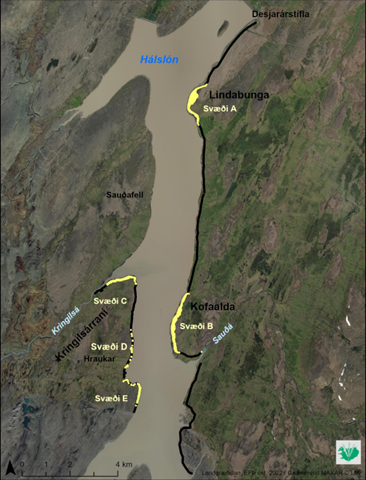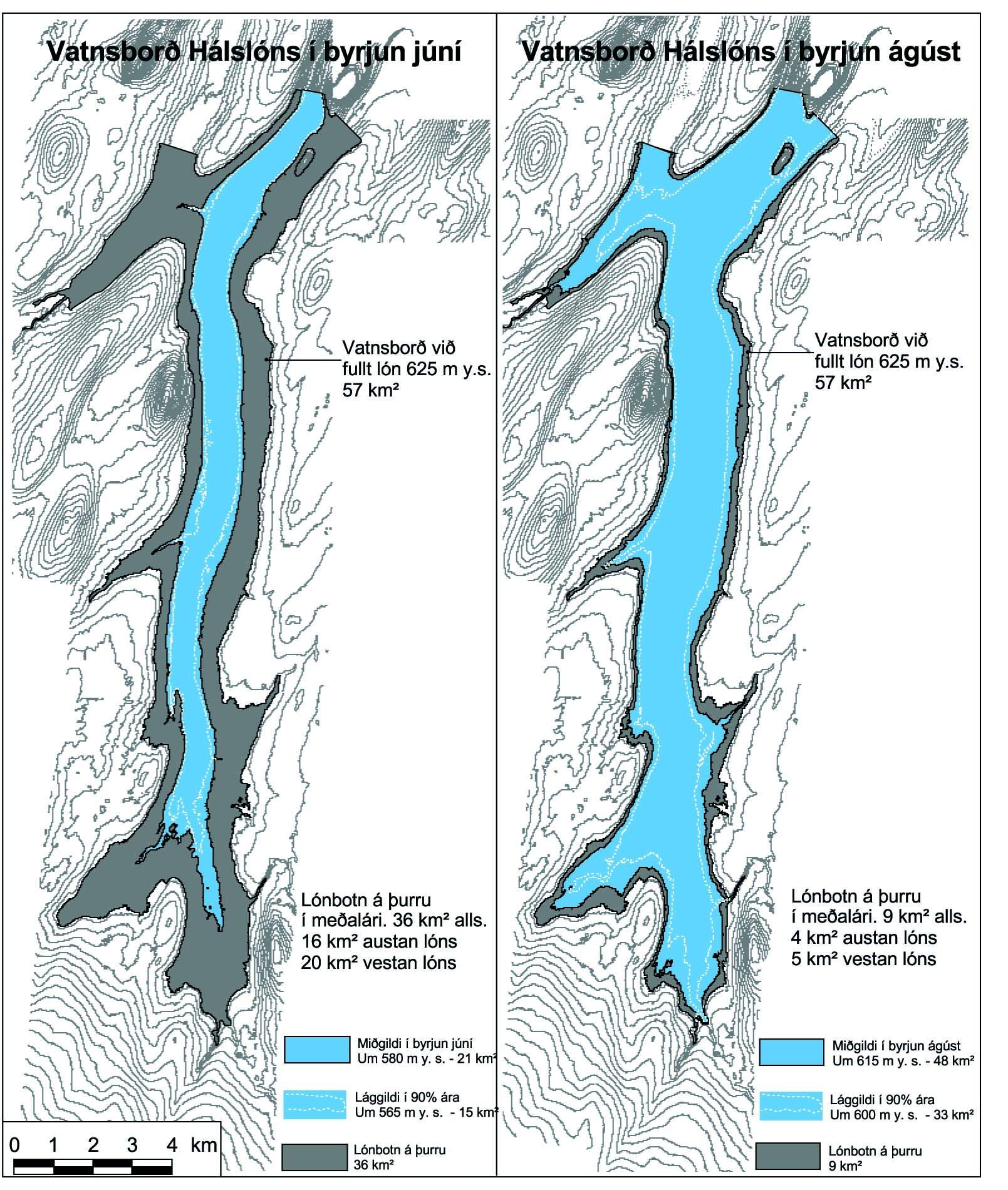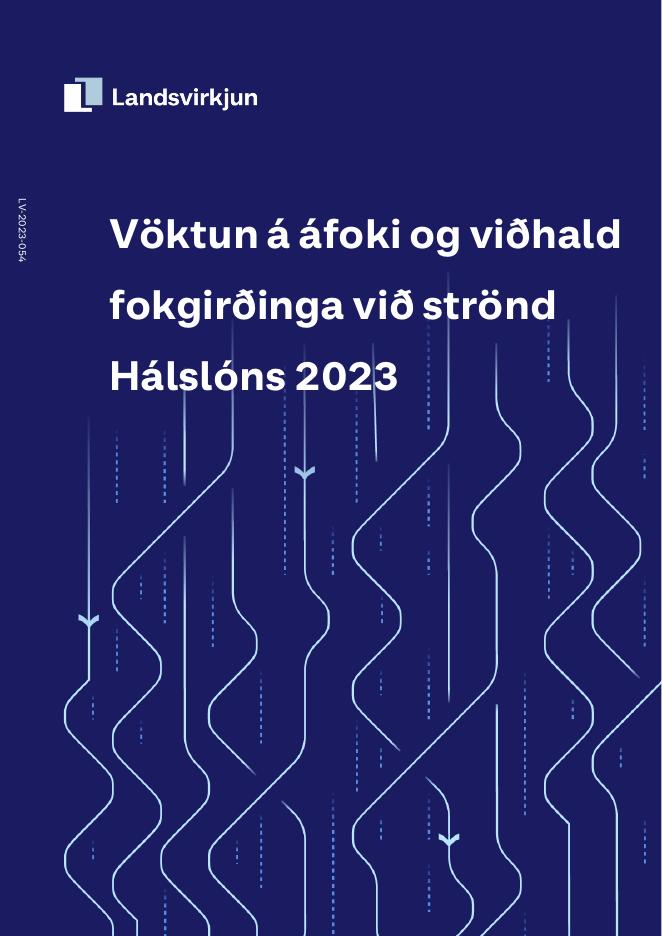Progress
The report on the environmental impact assessment of the Kárahnjúkar power plant states that it is essential to establish a monitoring system along all edges of the Hálslón reservoir since considerable erosion is to be expected in the first years/decades after its formation with the associated risk of aeolian deposits reaching vegetated areas. Following this, Landsvirkjun has monitored erosion proceedings at the Hálslón reservoir. Coastal areas have been walked and mapped to include erosion areas and mineral composition of the reservoir coast; erosion at the highest reservoir level has been monitored, and aerial photos have been taken regularly. Also, the coast has been geodetically measured in several transects, which helps to monitor the long-term development of the coast. Simultaneously, aeolian deposition is monitored above coastal areas. In addition to closely observing the progress of the coastal areas, erosion and encroachment defenses have been installed (see pictures above). The vegetation strengthened east of the Hálslón reservoir to survive the blowing sand better. A method to clean the sand of grown land has been developed. In 2014, the Soil Conservation Service of Iceland (Landgræðsla ríkisins) was asked to assess aeolian deposits at Hálslón reservoir and, at the same time, design a system to monitor long-term aeolian depositions. Concurrently, three measuring stations were set up at the Kringilsárrani area to monitor and measure aeolian deposition.
Further information on countermeasures and observations at the Hálslón reservoir can be found in reports under the "Further reading" tab (only in Icelandic).
Findings from inspection 2023:
The summer field trip took place from July 3-5, but due to unfavorable weather conditions, it was not possible to complete all the planned tasks. An additional trip was made on July 30 to complete the aeolian deposition measurements on the eastern shore of Hálslón. In addition to the traditional measurements of aeolian deposition spread, profiles of fixed measuring plots were set up. For the first time, measurements of soil thickening were conducted, providing information on the accumulation of aeolian materials.
The summer 2023 survey showed a significant increase in the spread of aeolian depositions in the measured areas, from 2 hectares in 2022 to 12.3 hectares in the summer of 2023. The thickness of the aeolian depositions was also significantly greater than previously measured, particularly at Lindabunga and Kofaöldu.
Despite this considerable aeolian deposition, the spread of aeolian deposition areas did not exceed the maximum spread recorded since 2014. This indicates that countermeasures are yielding good results, including applying fertilizers to the aeolian deposition areas, which is very important as vigorous vegetation can bind the aeolian materials and prevent them from spreading further into vegetated land.
Part of the sand fences north of the Kringilsá River were removed, and the sand fences on the eastern shore of Hálslón were inspected.
Figure 1. Hálslón and surroundings. The black line shows the area covered by the monitoring, and the yellow line shows the measured areas along the coastline.
Updated: June 6, 2024
Source: Landsvirkjun (2024)
Metrics, Targets and Monitoring Protocol
What is measured?
Coastal areas of Hálslón reservoir in spring and autumn. Areas where sand has drifted from the coast are recorded, their size estimated/measured as well as sand thickness (project effect: direct).
Monitoring Protocol
Visual monitoring. Data gathered after the reservoir is filled. Regular visits will be made to the area following storms.
Targets
No aeolian deposition east of the reservoir
Possible countermeasures
Landsvirkjun initiates countermeasures to prevent aeolian deposition.
Updated: January, 6th, 2016
Changes of indicator
At the annual meeting of the initiative on May 6 2015 the following proposed amendment was passed.
| Original text | Changed text |
|---|---|
| Volume of aeolian deposition from the east coast of the reservoir. |
Coastal areas of Hálslón reservoir in spring and autumn. Areas where sand has drifted from the coast are recorded, their size estimated/measured as well as sand thickness (project effect: direct). |
Rationale for changes: The monitoring protocol states analysis of volume of aeolian deposition east of the reservoir. It is technically difficult and not realistic to measure volume but possible to estimate area. In addition, the protocol only mentioned the East coast of the reservoir but Kringilsárrani area is also monitored and should be included in the monitoring protocol.
This indicator was originally number 26.2. It was then named Blowing Sand from Halslon Reservoir and can be found under that number in documents of the project from 2005 and 2006.
The indicator number has been changed twice.
| Year | Nr. | Indicator name |
|---|---|---|
| 2020 | 2.2.4 | Sand Encroachment by Hálslón |
| 2007 | 2.29 | Sand Encroachment by Hálslón Reservoir |
Baseline
The map to the right is a rendering of the reservoir in beginning of June on an average year. The water level is then 580 meters above sea level or 45 meters under the highest water level. During this period 16 km2, of the reservoir bed, are above water level on the east side of the reservoir. The right side of the map, shows the reservoir in early August during an average year. The water level is then 615 meters above sea level or 10 meters below the highest water level. During this period 4 km2 of the reservoir bed are above water level east of the reservoir and the potential for wind erosion has decreased. The thickness of the soil is estimated to be in average about 2-2.5 meters east of the reservoir. The area will be categorized according to land slope in order to evaluate beforehand where it is most likely that sand piles will form.
Research are ongoing on the stamina of the vegetation in the eastern part against aeolian deposition and how to react to possible deposition of minerals.
Rationale for Indicator Selection
Part of the reservoir shoreline area or approximately 15 km2 is covered with around 2.5 m thick soil coated with thin layer of vegetation. With time this volcanic soil can wash into the reservoir through water erosion and wave action, but also drift to surrounding area causing soil thickening and even vegetation loss.
With time wave erosion removes soil from Hálslón reservoir shoreline. The erosion rate is dependent on the slope of the shore area and the intensity of wave action. The erosion rate is highest on steeply sloping shore areas and slowest on flat plains on the shore.
On these gentle sloping planes the vegetation might disappear after a few years of reservoir operation, leaving only soil. On steeper shoreline areas erosion slumps can form in the soil before it is removed by wave erosion. These conditions may prevail during the first one or two decades of reservoir operation.
During dry storms from the south and southwest the exposed dry soil may be picked up by the wind and the largest particles drift onto adjacent vegetated area forming sand piles above the highest water level. In wetlands this risk is however greatly reduced. The east side of the reservoir is specially prone to aeolian deposition. On the west shoreline, windblown sand drifts chiefly to the reservoir during strong wind from South or South-West and therefore no sand piles are formed.
While soil prone to erosion remains, various operations are planned to prevent aeolian deposition to damage vegetated areas in Vesturöræfi wilderness. Sand traps were setup along vegetated areas by the east shoreline of the reservoir. Irrigation, dust binding and sand fences are planned as means to control drift of soil.
Measures to strengthen vegetation east of the reservoir, are also being considered.
Original Rationale for Indicator Selection
The area that will be inundated once Halslon Reservoir is created has relatively thick volcanic soil beneath the vegetation. With time, the vegetation by the reservoir shoreline will disappear and this will leave the soil unprotected from wind and wave erosion. The soil could be flushed into the reservoir or blown to surrounding areas, causing the thickening of the soil or even destruction of vegetation. The smallest particles create dust but do not have negative effect on vegetation. The larger particles that move on the surface in sand piles pose a greater threat since they can suffocate vegetation closest to the reservoir.
When wind is strong, it usually blows from the southwest. Soil from west of the reservoir will therefore blow into the water but soil from the east side could blow over the vegetation on Vesturoraefi if no mitigation measures are taken. This danger is greatest in the first half of summer once the surface has dried up from spring thaws and the reservoir has not yet filled. Wetlands are less affected by wind erosion since groundwater keeps the soil wet.
Part of the soil that creates the wind erosion threat will slide into the reservoir with time. This will happen first in areas where slopes are greater than seven percent. Landsvirkjun plans to remove the soil from the flattest areas by pumping it into the deepest part of the reservoir. If those plans succeed, the soil on the east shoreline of the reservoir should be gone about 10 or 15 years after the dam starts to operate because of erosion or pumping
During the time soil erosion and creation of sand piles are still an issue, several mitigation measures are planned to prevent sand from piling up and destroying vegetated areas on Vesturoreafi. These measures include special protection walls, sand traps, fences, and sand erosion banks. Measures to strengthen vegetation east of the reservoir, in case of damage, are also being considered.
From phase I/II report on indicators and baseline from April 2005
Further reading
You can view more material related to the indicator by clicking on the link above.



